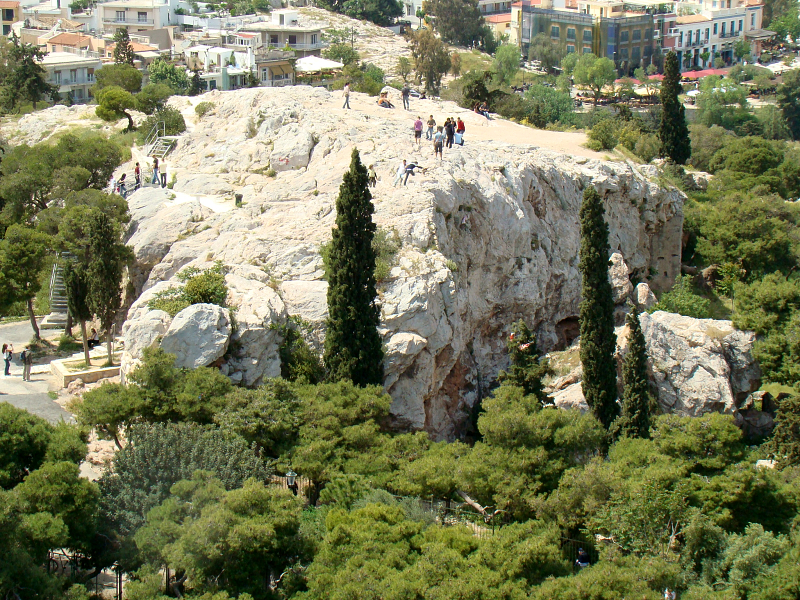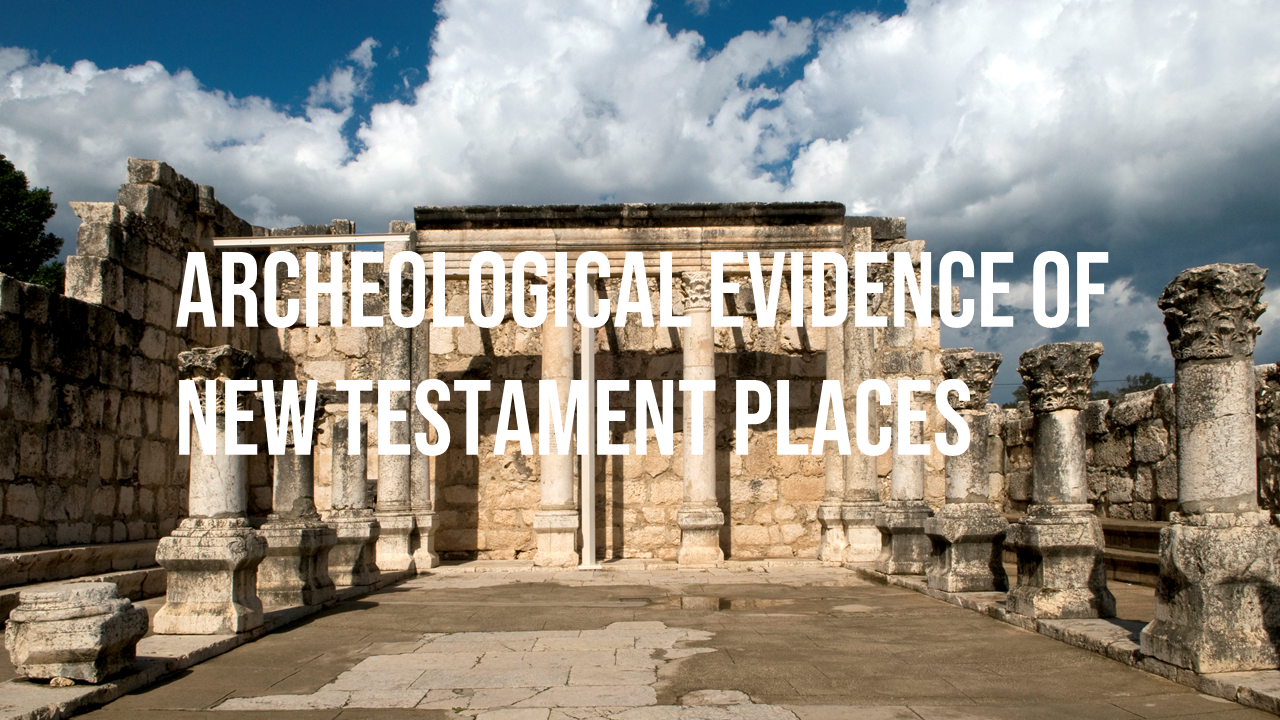
Real Locations, Real Events…Real People !
Place That Existed : Beth-Shan and The Dacapolis
The biblical city of Beth Shan has been excavated since the 1920s and 1930s and has revealed an occupation beginning from approximately 4500 BC and extending to the eleventh century AD. It is the location where the bodies of King Saul and his sons were fastened on the city walls (1 Samuel 31:8-13) after their deaths in battle with the Philistines. The temple unearthed at the site also may be the Temple of Dagon, where Saul and Jonathan’s armor and heads were exhibited (1 Chronicles 10:10). In addition, Beth Shan was also known as Scythopolis, one of the ten cities of the Decapolis in the first century AD. Today, nine of the ten cities of the Decapolis in Matthew 4:25, Mark 5:20, 7:31 have been positively identified.
Joseph M. Holden;Norman Geisler. The Popular Handbook of Archaeology and the Bible: Discoveries That Confirm the Reliability of Scripture (Kindle Locations 820-825)
And it came about on the next day when the Philistines came to strip the slain, that they found Saul and his three sons fallen on Mount Gilboa. And they cut off his head, and stripped off his weapons, and sent them throughout the land of the Philistines, to carry the good news to the house of their idols and to the people. And they put his weapons in the temple of Ashtaroth, and they fastened his body to the wall of Beth-Shan.
Isaiah 31:8-10
And great multitudes followed Him from Galilee and Decapolis and Jerusalem and Judea and from beyond the Jordan.
Matthew 4 :25
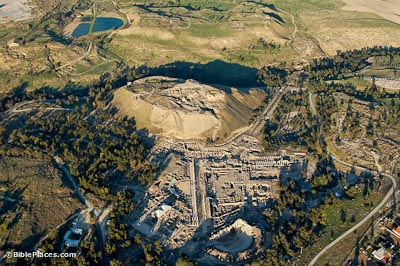
Robinson’s Arch
Robinson’s Arch – Remains of an archway which connected a monumental staircase going into the Jerusalem’s Temple platform during the Second Temple period. It was a major entry point to the Temple mount platform, and would have very likely been used by Jesus and His followers. The arch was first identified in 1838 by Edward Robinson. Robinson was an American who taught at Andover Theological Seminary and is considered to be the father of Biblical geography which laid the foundation for Biblical archaeology in Europe and America. (exposittheword.com)
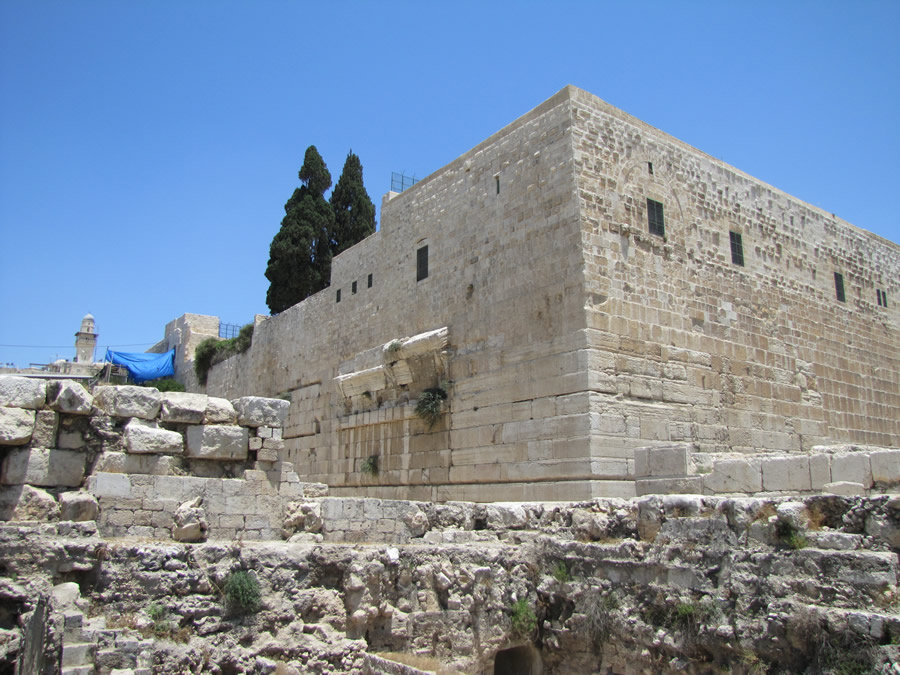
Herodian Ashlars At Base of Western Wall
Herodian Ashlars at the Base of the Western Wall – Very large carved limestone blocks from the Jewish Temple platform of the Second Temple Period, lie scattered at the base of the Western Temple wall in Jerusalem. Jesus predicted the end of the Jerusalem Temple and stated that “…not one stone will be left upon another. All will be cast down” (Matt. 24:1-2). The Romans destroyed the temple and dismantled it, and cast all of the building stones down in A.D. 70. Discovered in the 20th Century. The event was commemorated in the Arch of Titus & Vespasian in Rome where there is an image of the 10th Roman Legion carrying off the gold menorah which was used in the Jewish Temple. Interestingly, the gold recovered from the Jewish temple was used by the Romans to fund the building of the Flavian Amphitheater (the Colosseum) in Rome. (exposittheword.com)
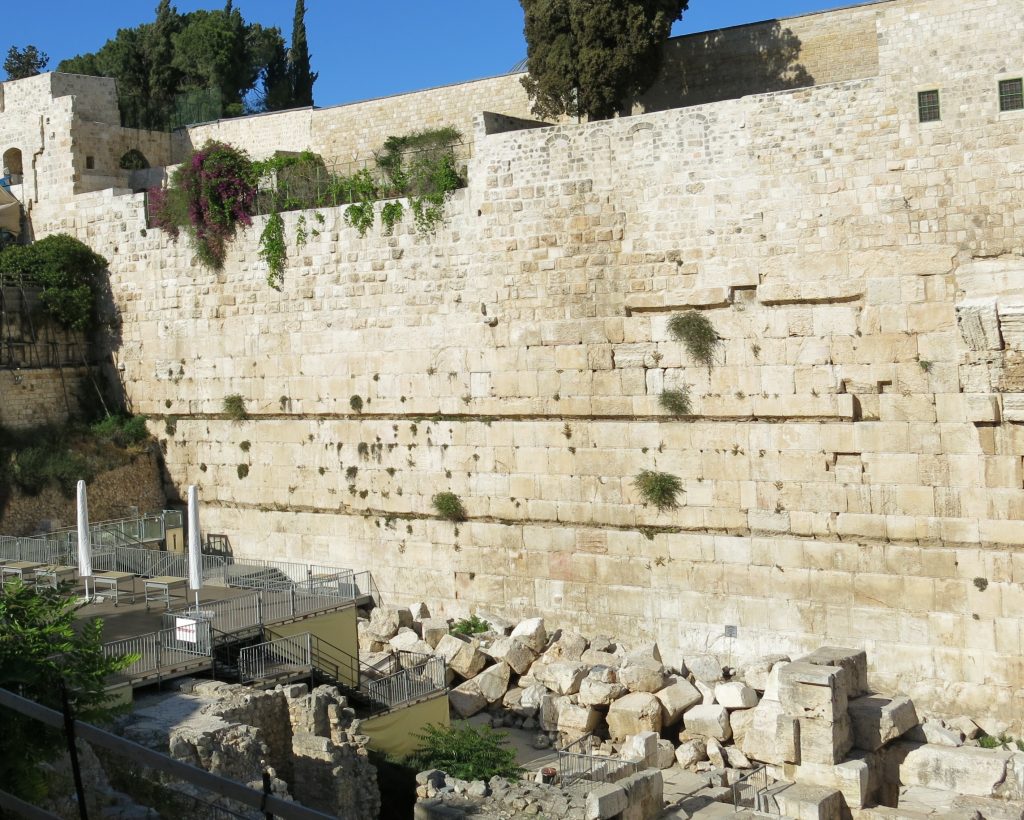
Synagogue at Capernaum
Synagogue at Capernaum – Remains of the First Century Jewish synagogue where Jesus spoke and performed a miracle has been excavated. The synagogue also marks the beginning of His public ministry. The site was first identified by Sir Charles Warren in the 19th Century. Further research has confirmed it’s identity.
And they went into Capernaum; and immediately on the Sabbath He entered the synagogue and began to teach. And they were amazed at His teaching; for He was teaching them as one having authority, and not as the scribes. And just then there was in their synagogue a man with an unclean spirit; and he cried out, saying, “What do we have to do with You, Jesus of Nazareth? Have You come to destroy us? I know who You are– the Holy One of God!” And Jesus rebuked him, saying, “Be quiet, and come out of him!”
Mark 1:21-25
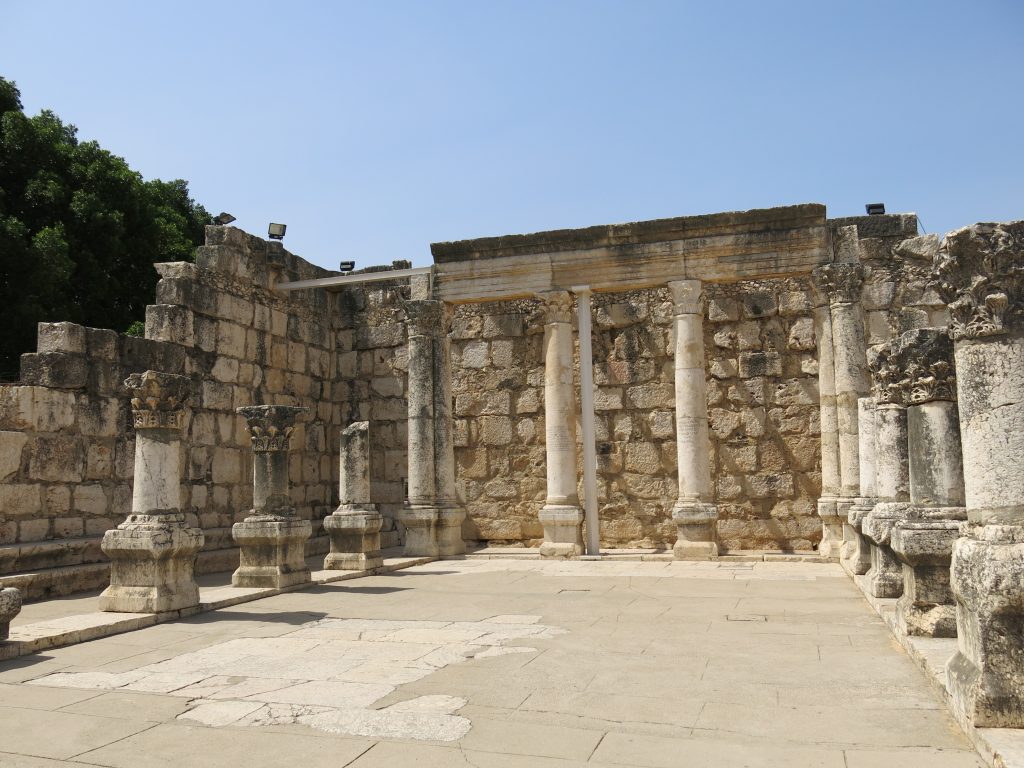
Peter’s House In Capernaum
Capernaum contains the remains of an octagonal 5th century church. In 1968, archaeologists discovered the remains of an earlier church underneath it. This had been built around what was originally a private house, which was apparently used by Christians as a meeting-place during the second half of the first century. The walls had been plastered, and bore scratched writing interpreted by some scholars as prayers in ancient Aramaic (as well as Syriac and Hebrew) saying such things as “Lord Jesus Christ help” and “Christ have mercy”. As often seems to be the case with ancient scratched markings, these readings are disputed. Some scholars think they “are better read as Greek than as Aramaic … and do not necessarily have religious significance.” In the fourth century this ‘house church’ was enlarged and enclosed within the walls of its own compound. It was pointed out to early pilgrims such as Egeria, the mother of emperor Constantine, who recorded c. AD 380 that: “In Capernaum the house of the prince of the apostles has been made into a church with its original walls still standing. It is where the Lord cured the paralytic.”
Peter Walker affirms: “graffiti that referred to Jesus as Lord and Messiah … provides strong evidence that the room was used as a place of Christian worship – almost certainly because it was believed to be the room used by Jesus, perhaps the home of Simon Peter Luke 4:38… Given that the early tradition goes back to the first century, this is almost certainly the very place where Jesus stayed – the home of his chief apostle, Simon Peter.”bethinking.org
And He came down to Capernaum, a city of Galilee. And He was teaching them on the Sabbath …
And He arose and left the synagogue, and entered Simon’s home. Now Simon’s mother-in-law was suffering from a high fever; and they made request of Him on her behalf. And standing over her, He rebuked the fever, and it left her; and she immediately arose and waited on them.
Luke 4:31,38-39
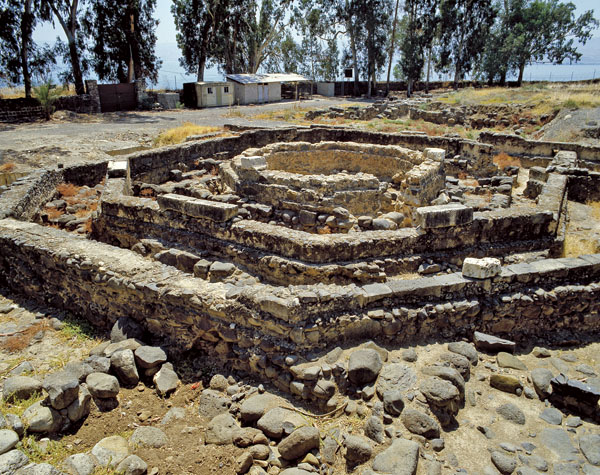
The Pool of Bethesda
John 5:1-15 describes a pool in Jerusalem, near the Sheep Gate, called Bethesda, surrounded by five covered colonnades. Until the 19th century, there was no evidence outside of John for the existence of this pool and John’s unusual description “caused bible scholars to doubt the reliability of John’s account, but the pool was duly uncovered in the 1930s – with four colonnades around its edges and one across its middle.” Ian Wilson reports: “Exhaustive excavations by Israeli archaeologist Professor Joachim Jeremias have brought to light precisely such a building, still including two huge, deep-cut cisterns, in the environs of Jerusalem’s Crusader Church of St Anne.” bethinking.org
After these things there was a feast of the Jews, and Jesus went up to Jerusalem. Now there is in Jerusalem by the sheep gate a pool, which is called in Hebrew Bethesda, having five porticoes.
John 15:1-2
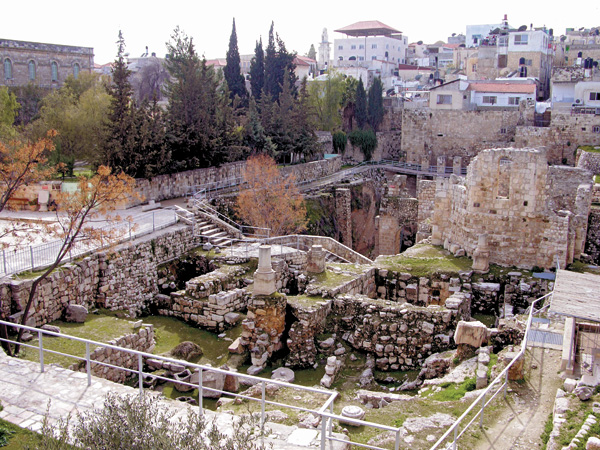
The Pool Of Siloam
During sewerage works in June 2004 engineers stumbled upon a 1st century ritual pool when they uncovered some ancient steps during pipe maintenance near the mouth of Hezekiah’s tunnel. By the summer of 2005, archaeologists had revealed what was “without doubt the missing pool of Siloam.” mentioned in John 9:1-7 when Jesus healed a blind man. Mark D. Roberts reports that: “In the plaster of this pool were found coins that establish the date of the pool to the years before and after Jesus. There is little question that this is in fact the pool of Siloam, to which Jesus sent the blind man in John 9.” bethinking.org
And as He passed by, He saw a man blind from birth. And His disciples asked Him, saying, “Rabbi, who sinned, this man or his parents, that he should be born blind?” Jesus answered, “It was neither that this man sinned, nor his parents; but it was in order that the works of God might be displayed in him. “We must work the works of Him who sent Me, as long as it is day; night is coming, when no man can work. “While I am in the world, I am the light of the world.” When He had said this, He spat on the ground, and made clay of the spittle, and applied the clay to his eyes, and said to him, “Go, wash in the pool of Siloam ” (which is translated, Sent). And so he went away and washed, and came back seeing.
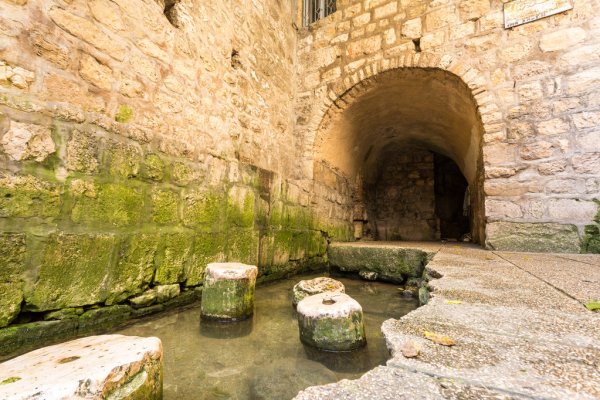
The Tomb of the Gadarene Demoniac
Angela Tilby reports that: “Umm Keiss contains the remains of the ancient town of Gadera … noted for its hot, natural pools that were thought to have healing qualities. The town is on the south side of the Sea of Galilee in an area known as the Decapolis. This is the region to the south and east of the Jordan in which there were ten independent cities founded originally by Alexander the Great. At the time of Jesus these remained cosmopolitan communities where temples and synagogues would be found alongside each other. Jew and pagan would trade and mix … under the wider cultural umbrella of whatever colonial power was in the ascendancy. Recent excavations have uncovered the remains of a fourth-century church, which is so large that it must have been connected to a site of major importance. The church has no less than five aisles, which suggests that it was visited by large numbers of pilgrims. Digging down beneath the foundations, archaeologists have discovered a Roman tomb that has been dated to the year AD 25… The strange thing is that the church has a hole in the floor that looks right down on to the tomb. The tomb itself is in an easily identified spot; it is just under an archway that marks the western city boundary. The Christians who built the church have done nothing to ‘christianize’ the tomb. They have neither destroyed it, replaced it, nor attempted to mark it with crosses or symbols of resurrection. For some reason, they wanted to preserve it as it was. It is a serious possibility that this was one of the tombs that provided a home for the Gadarene demoniac. It has been preserved under the church to mark the place of his exorcism.” bethinking.org
And they came to the other side of the sea, into the country of the Gerasenes. And when He had come out of the boat, immediately a man from the tombs with an unclean spirit met Him, and he had his dwelling among the tombs. And no one was able to bind him anymore, even with a chain; because he had often been bound with shackles and chains, and the chains had been torn apart by him, and the shackles broken in pieces, and no one was strong enough to subdue him. And constantly night and day, among the tombs and in the mountains, he was crying out and gashing himself with stones. And seeing Jesus from a distance, he ran up and bowed down before Him
Mark 5:1-6

Bethany And The Tomb Of Lazarus
Peter Walker writes: “There is no doubting the general location of Bethany. The Arabic village of El-Azarieh preserves in its name the way the Byzantines referred to it – as the ‘Lazarium’, that is, ‘the place of Lazarus’. Until recently this was a tiny village… There is a strong likelihood that Lazarus’ tomb has been correctly identified and preserved. Certainly the traditional tomb that is now known as his tomb was in a cemetery in the first century (other first-century tombs have been found just to the north). And there are references to the tomb going back to the third century AD (in Eusebius’ Onomastikon).” bethinking.org
But some of them said, “Could not this man, who opened the eyes of him who was blind, have kept this man also from dying?” Jesus therefore again being deeply moved within, came to the tomb. Now it was a cave, and a stone was lying against it. Jesus said, “Remove the stone.” Martha, the sister of the deceased, said to Him, “Lord, by this time there will be a stench, for he has been dead four days.” Jesus said to her, “Did I not say to you, if you believe, you will see the glory of God?” And so they removed the stone. And Jesus raised His eyes, and said, “Father, I thank Thee that Thou heardest Me. “And I knew that Thou hearest Me always; but because of the people standing around I said it, that they may believe that Thou didst send Me.” And when He had said these things, He cried out with a loud voice, “Lazarus, come forth.” He who had died came forth, bound hand and foot with wrappings; and his face was wrapped around with a cloth. Jesus said to them, “Unbind him, and let him go.”
John 11:37-44
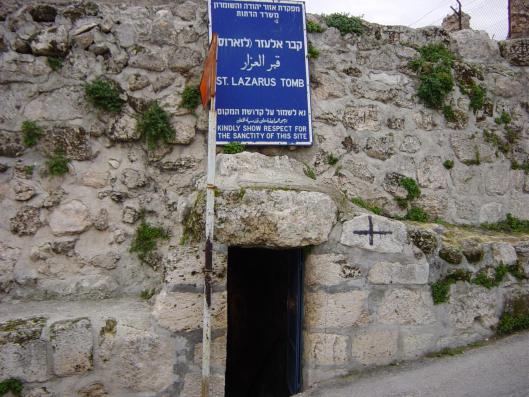
The City of Bethsaida
The ruins of Bethsaida lie atop an oval-shaped, 20-acre mound of volcanic earth. Flowing all around are the hills of the Golan, which plunge through stands of eucalyptus and across plains of mango and palm groves to the Sea of Galilee.
Bethsaida was home to as many as five apostles—far more than any other New Testament town. It was where Jesus is said to have healed the blind man and multiplied the loaves and fishes. And it was the target of his notorious curse—the “Woe” saying—in which he lashes out at Bethsaida and two other towns for their failure to repent.
Woe to you, Chorazin! Woe to you, Bethsaida! For if the mighty works done in you had been done in Tyre and Sidon, they would have repented long ago in sackcloth and ashes. 22 But I tell you, it will be more bearable on the day of judgment for Tyre and Sidon than for you.
The next day Jesus decided to go to Galilee. He found Philip and said to him, “Follow me.” 44 Now Philip was from Bethsaida, the city of Andrew and Peter.
Matthew 11:21-22
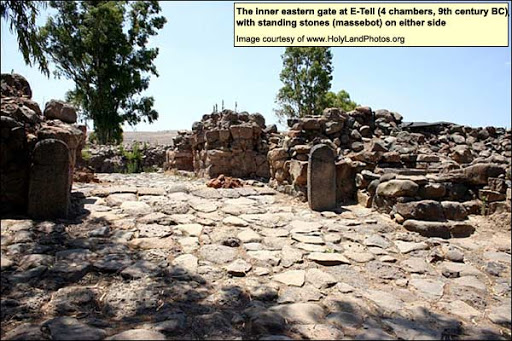
Ruins of The City Of Ephesus
Ephesus was an ancient Greek city on the coast of Ionia, three kilometres southwest of present-day Selcuk in Ismir Province, Turkey. The city was famed for the Temple of Artemis, one of the Seven Wonders of the Ancient world. Ephesus was significantly historical from a biblical standpoint for many reasons:
- Ephesus was one of the seven churches of Asia that are cited in the Book of Revelation.
- The Bible’s Book of Ephesians was written by Paul to the church there.
- Timothy, who Paul discipled, and wrote the Bible Books 1 Timothy and 2 Timothy to was the pastor there.
- The church historian, Eusebius, quotes second century sources (Irenaeus and Clement of Alexandrea), saying that the apostle John lived in Ephesus until the end of his life. His tomb is purportedly there.
Paul, an apostle of Christ Jesus by the will of God, to the saints who are at Ephesus, and who are faithful in Christ Jesus: Grace to you and peace from God our Father and the Lord Jesus Christ.
Ephesians 1:1-2
Paul, an apostle of Christ Jesus according to the commandment of God our Savior, and of Christ Jesus, who is our hope; to Timothy, my true child in the faith: Grace, mercy and peace from God the Father and Christ Jesus our Lord. As I urged you upon my departure for Macedonia, remain on at Ephesus, in order that you may instruct certain men not to teach strange doctrines
1 Timothy 1:1-3
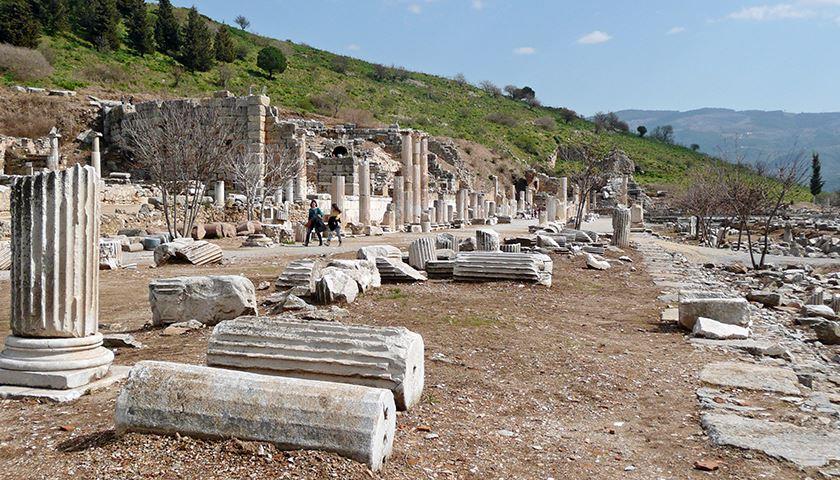
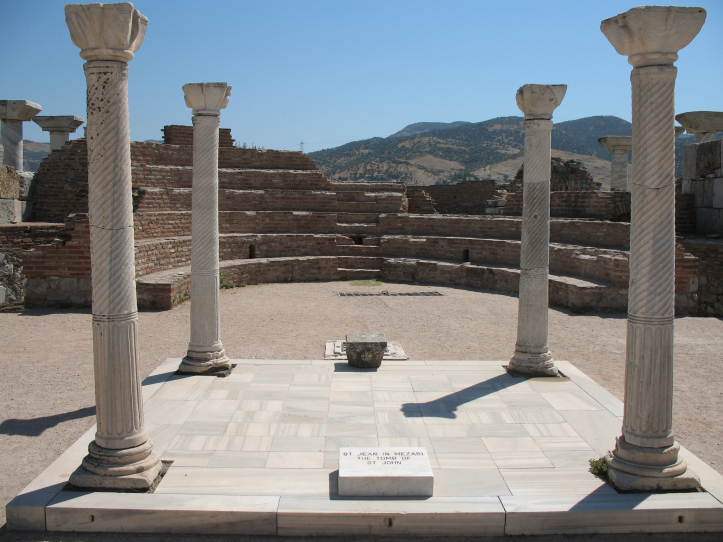
The Temple Of Artemis
The Temple of Artemis was located in the ancient city of Ephesus located three kilometres southwest of present-day Selcuk in Ismir. It was one of the Seven Wonders of the Ancient World and once stood 418 ft by 239 ft with over 100 marble pillars each 56 ft high. The temple earned the city the title “Servant of the Goddess”. Pliny tells us that the magnificent structure took 120 to build.
The Temple and the god Artemis play a prominent role in a biblical episode involving Paul and silversmith in Acts 19:21. Since Ephesus was very much a polytheistic city as was common of Roman provinces, silversmith’s made much of their income by making miniature images or statues of the gods.
For a certain man named Demetrius, a silversmith, who made silver shrines of Artemis, was bringing no little business to the craftsmen; these he gathered together with the workmen of similar trades, and said, “Men, you know that our prosperity depends upon this business. “And you see and hear that not only in Ephesus, but in almost all of Asia, this Paul has persuaded and turned away a considerable number of people, saying that gods made with hands are no gods at all. “And not only is there danger that this trade of ours fall into disrepute, but also that the temple of the great goddess Artemis be regarded as worthless and that she whom all of Asia and the world worship should even be dethroned from her magnificence.”
Acts 19:24-27
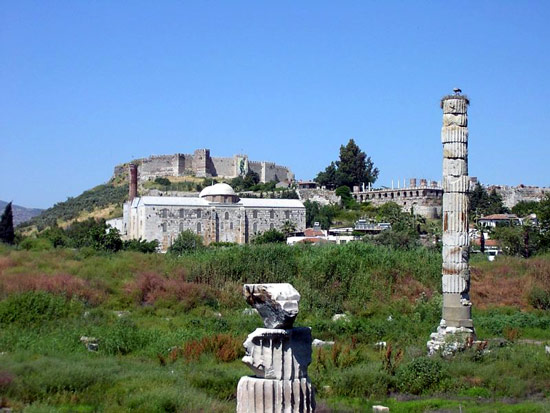
The Grand Theatre In Ephesus
The Great Theatre was constructed in the Hellenistic period but remodeled many times in the Roman period. It took 60 years to complete and it is the largest theater in the Asia Minor was able to accommodate 25,000. By comparison Madison Square Garden can hold 20.000 people.
The Theatre in Ephesus served not only for dramatic performances, but also for demonstrations of a social, political, economic, religious nature. It is where the Apostle Paul gave a famous defense of the Christian faith in Acts 19:38.
And when Paul wanted to go into the assembly, the disciples would not let him. And also some of the Asiarchs who were friends of his sent to him and repeatedly urged him not to venture into the theater. So then, some were shouting one thing and some another, for the assembly was in confusion, and the majority did not know for what cause they had come together.
Acts 19:30-32

The Areopagus
The Areopagus is a prominent rock outcropping located northwest of the Acropolis in Athens, Greece. Its English name is the Late Latin composite form of the Greek name Areios Pagos, translated “Hill of Ares”
It was the location of a court, that tried cases of deliberate homicide, wounding and religious matters. It is where the Apostle Paul gave a famous sermon to the men of Athens in Acts 17:18-34
“He seems to be a proclaimer of strange deities,”– because he was preaching Jesus and the resurrection. And they took him and brought him to the Areopagus, saying, “May we know what this new teaching is which you are proclaiming?
Acts 18-19
